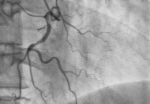Severe mitral regurgitation is associated to cardiac failure and hospitalization and over time is accompanied by kidney failure, which leads to higher mortality. In the COAPT study, in patients with low ejection fraction, MitraClip showed benefits over medical treatment, but there was an important group of people with kidney function deterioration. The evolution and benefit...
DISCO RADIAL: Conventional or Distal Transradial Access?
Conventional transradial access (TRA) is already established as the access of choice for percutaneous coronary procedures, regardless of clinical presentation. This choice is based on multiple randomized studies and meta-analyses that have shown reduced bleeding at the puncture site, less vascular complications, and benefits on mortality (mainly in high-risk patients). The practicality of recovery allows...
EuroPCR 2022 | The IMPROVED-CTO Trial
PCI success rate in chronic total occlusion (CTO), according to some registries, is below 80%. These failed revascularization procedures might lead to quality-of-life deterioration and shorter survival. This concern has driven the development of new techniques and technologies in an attempt to increase PCI success. Today, approximately 20% of CTOs are treated with a second...
EuroPCR 2022 | Changes in Cardiac Damage after Surgical Aortic Valve Replacement
This study presented at EuroPCR 2022 analyzed the PARTNER study pool and included 1974 patients with a complete echocardiogram. Surgical risk was 17.3% extreme/inoperable, 54.3% intermediate and 28.4% low. 60% received transcatheter aortic valve replacement (TAVR) and the rest surgical aortic valve replacement (SAVR). 6.1% of patients were in stage 0 (no damage), 14.5% were...
Is High Mean Gradient After Edge-to-Edge Strategy Important?
Edge-to-edge treatment of the mitral valve is currently a valid alternative to surgery in cases of mitral regurgitation. Different studies have taken residual mitral regurgitation as a parameter of success, but little research has been conducted on the residual gradient once the procedure has been completed. What has been published is that a mean gradient...
Transfemoral vs Transradial Approach in the Percutaneous Treatment of CTO
Percutaneous treatment of chronic total occlusion (CTO) has traditionally been via the transfemoral approach (TFA). The use of the transradial approach (TRA) in complex coronary interventions has been increasing. A randomized study assessed the use of TRA vs TFA in complex PCI (58% CTO) and TRA saw favorable outcomes. The aim of this prospective, randomized,...
Should We Worry about Non-Ischemic Lesions?
In the last decade, the interest in atheroma plaque morphology and its role in clinical events has been on the rise. Several studies have shown the use of IVUS to sort out plaque into lipidic rich (LRP) and thin cap fibroatheromas (TCFA). These morphologies have been associated with major cardiovascular events at followup. At...
Coronary Flow Reserve in Patients with Intermediate FFR: Should We Use This Tool to Define When to Perform Coronary Angioplasty?
Current guidelines recommend using fractional flow reserve (FFR) to guide coronary angioplasty. However, intermediate FFR values (0.75-0.80) generate uncertainty about the prognostic value of performing coronary angioplasty over optimal medical treatment. The use of coronary flow reserve (CFR) together with FFR provides further insight into coronary circulation because CFR is an index that also includes...
Coronary Angioplasty Evolution According to Syntax II: 5-Year Followup
It has been long since the SYNTAX (NEJM 2009) came out comparing percutaneous coronary intervention (PCI) against coronary artery bypass grafting (CABG). That emblematic study associated PCI with first generation drug eluting stents (Taxus) with increased major cardiac and cerebrovascular events (all-cause mortality, AMI, stroke, or any revascularization – MACCE) vs. CABG, at 5 years,...
IVUS-Guided Coronary Angioplasty: Promising Results at 3-Year Follow-Up
Intravascular ultrasound (IVUS) to guide drug-eluting stent (DES) implantation has been evaluated in several studies. Two randomized studies, IVUS-XPL (Impact of Intravascular Ultrasound Guidance on the Outcomes of Xience Prime Stents in Long Lesions) and ULTIMATE (Intravascular Ultrasound Guided Drug Eluting Stents Implantation in All-Comers Coronary Lesions), have shown fewer repeat revascularizations compared with angiography-guided...








